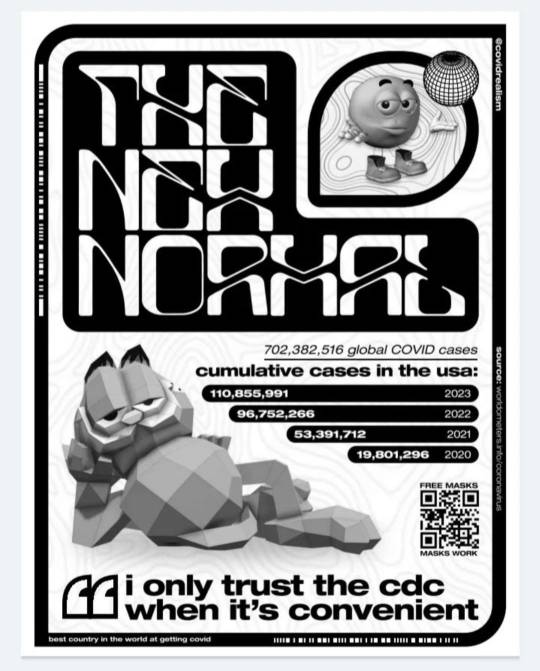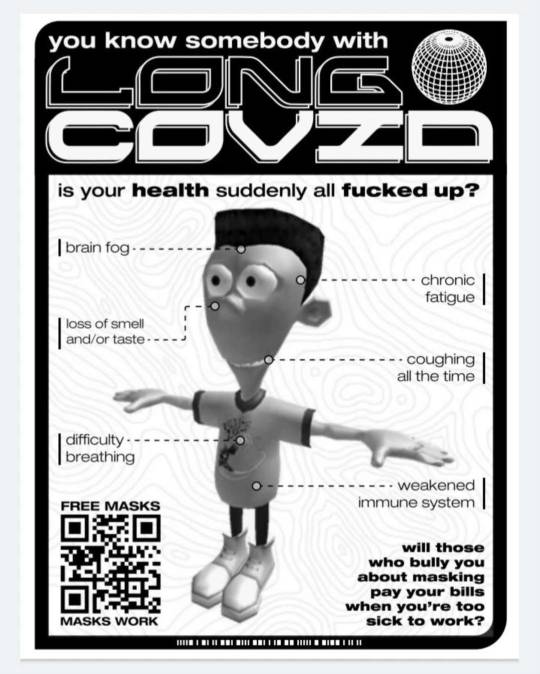Text
"Mild" covid cases show notable neural injury even 10 months after infection
21 notes
·
View notes
Text
Preprint published April 26, 2024
Abstract
The JN.1 variant (BA.2.86.1.1), arising from BA.2.86(.1) with the S:L455S substitution, exhibited increased fitness and outcompeted the previous dominant XBB lineage by the biggening of 2024. JN.1 subsequently diversified, leading to the emergence of descendants with spike (S) protein substitutions such as S:R346T and S:F456L. Particularly, the KP.2 (JN.1.11.1.2) variant, a descendant of JN.1 bearing both S:R346T and S:F456L, is rapidly spreading in multiple regions as of April 2024. Here, we investigated the virological properties of KP.2. KP.2 has three substitutions in the S protein including the two above and additional one substitution in non-S protein compared with JN.1. We estimated the relative effective reproduction number (Re) of KP.2 based on the genome surveillance data from the USA, United Kingdom, and Canada where >30 sequences of KP.2 has been reported, using a Bayesian multinomial logistic model. The Re of KP.2 is 1.22-, 1.32-, and 1.26-fold higher than that of JN.1 in USA, United Kingdom, and Canada, respectively. These results suggest that KP.2 has higher viral fitness and potentially becomes the predominant lineage worldwide. Indeed, as of the beginning of April 2024, the estimated variant frequency of KP.2 has already reached 20% in United Kingdom. The pseudovirus assay showed that the infectivity of KP.2 is significantly (10.5-fold) lower than that of JN.1. We then performed a neutralization assay using monovalent XBB.1.5 vaccine sera and breakthrough infection (BTI) sera with XBB.1.5, EG.5, HK.3 and JN.1 infections. In all cases, the 50% neutralization titer (NT50) against KP.2 was significantly lower than that against JN.1. Particularly, KP.2 shows the most significant resistance to the sera of monovalent XBB.1.5 vaccinee without infection (3.1-fold) as well as those who with infection (1.8-fold). Altogether, these results suggest that the increased immune resistance ability of KP.2 partially contributes to the higher Re more than previous variants including JN.1.
Major takeaway: Covid continues to evolve towards immune escape even with vaccination. Mask up to stop the spread. It's the only way to truly stop covid.
#mask up#covid#covid 19#covid isn't over#pandemic#covid conscious#covid is airborne#wear a mask#coronavirus
35 notes
·
View notes
Text
https://www.business-standard.com/article/current-affairs/wearing-mask-can-reduce-covid-19-infection-by-53-says-study-121111800899_1.html
"While vaccinations are safe, effective and saving lives around the world against Covid, wearing masks is the most effective public health measure that can reduce the incidence of the deadly infectious disease by more than half, according to a study.
The study led by an international team of researchers from Australia, the UK and China conducted a systematic review and meta-analysis of non-pharmaceutical interventions showing for the first time that mask wearing, social distancing and handwashing are all effective measures at curbing cases -- with mask wearing the most effective."
This is older (published 2021) but shows the fallacy that "we don't have the studies that show masks work." We did. We still do. Masks work. The study in question was of universal masking with surgical and cloth masks, and used statistical analysis to show the reduction of covid infections by using single protections. That's why it's important to stack protections (such as ventilation, nasal prophylactic sprays, limiting exposure time, and distancing when possible) and wear a well fitting respirator to avoid catchibg covid as universal masking becomes a thing of the past.
#masks work#mask up#covid#covid 19#covid isn't over#pandemic#covid conscious#covid is airborne#wear a mask#coronavirus
37 notes
·
View notes
Text
Published April 25, 2024
Abstract
An improved understanding of the underlying physicochemical properties of respiratory aerosol that influence viral infectivity may open new avenues to mitigate the transmission of respiratory diseases such as COVID-19. Previous studies have shown that an increase in the pH of respiratory aerosols following generation due to changes in the gas-particle partitioning of pH buffering bicarbonate ions and carbon dioxide is a significant factor in reducing SARS-CoV-2 infectivity. We show here that a significant increase in SARS-CoV-2 aerostability results from a moderate increase in the atmospheric carbon dioxide concentration (e.g. 800 ppm), an effect that is more marked than that observed for changes in relative humidity. We model the likelihood of COVID-19 transmission on the ambient concentration of CO2, concluding that even this moderate increase in CO2 concentration results in a significant increase in overall risk. These observations confirm the critical importance of ventilation and maintaining low CO2 concentrations in indoor environments for mitigating disease transmission. Moreover, the correlation of increased CO2 concentration with viral aerostability need to be better understood when considering the consequences of increases in ambient CO2 levels in our atmosphere.
#mask up#covid#covid 19#covid isn't over#covid conscious#covid is airborne#pandemic#wear a mask#coronavirus#clean air
26 notes
·
View notes
Text
Published April 27, 2024
Abstract
It is well known the potential of severe acute respiratory coronavirus type 2 (SARS-CoV-2) infection to induce post-acute sequelae, a condition called Long COVID. This syndrome includes several symptoms, but the central nervous system (CNS) main one is neurocognitive dysfunction. Recently it has been demonstrated the relevance of plasma levels of neurofilament light chain (pNfL), as a biomarker of early involvement of the CNS in COVID-19. The aim of this study was to investigate the relationship between pNfL in patients with post-acute neurocognitive symptoms and the potential of NfL as a prognostic biomarker in these cases. A group of 63 long COVID patients ranging from 18 to 59 years-old were evaluated, submitted to a neurocognitive battery assessment, and subdivided in different groups, according to results. Plasma samples were collected during the long COVID assessment and used for measurement of pNfL with the Single molecule array (SIMOA) assays. Levels of pNfL were significantly higher in long COVID patients with neurocognitive symptoms when compared to HC (p = 0.0031). Long COVID patients with cognitive impairment and fatigue symptoms presented higher pNfL levels when compared to long COVID patients without these symptoms, individually and combined (p = 0.0263, p = 0.0480, and 0.0142, respectively). Correlation analysis showed that levels of cognitive lost and exacerbation of fatigue in the neurocognitive evaluation had a significative correlation with higher pNfL levels (p = 0.0219 and 0.0255, respectively). Previous reports suggested that pNfL levels are related with higher risk of severity and predict lethality of COVID-19. Our findings demonstrate that SARS-CoV-2 infection seems to have a long-term impact on the brain, even in patients who presented mild acute disease. NfL measurements might be useful to identify CNS involvement in long COVID associated with neurocognitive symptoms and to identify who will need continuous monitoring and treatment support.
#mask up#covid#covid 19#covid isn't over#pandemic#covid conscious#long covid#covid is airborne#wear a mask#coronavirus
40 notes
·
View notes
Text
83 notes
·
View notes
Text
#covid resource#mask up#covid#covid 19#covid isn't over#pandemic#covid conscious#long covid#covid is airborne#wear a mask#coronavirus
35 notes
·
View notes
Text

#mask up#covid#covid 19#covid isn't over#pandemic#covid conscious#long covid#covid is airborne#wear a mask#coronavirus#skeleton#bones
71 notes
·
View notes
Text

#garfeild#mask up#covid#covid 19#covid isn't over#pandemic#covid conscious#long covid#covid is airborne#wear a mask#coronavirus
16 notes
·
View notes
Text

#jimmy neutron#sheen#mask up#covid#covid 19#covid isn't over#pandemic#covid conscious#long covid#covid is airborne#wear a mask#coronavirus
53 notes
·
View notes
Text

Passover seder at UC Berkeley’s Gaza solidarity encampment (via twitter)
4K notes
·
View notes
Text
Unpopular opinion: we should all wear masks as much as possible. Forever.
Immuno compromised people were in danger long before 2019. How many people could we have saved, just by masking?
Seriously. Disabled people deserve to live without fear.
We never know if we're carrying a disease or not, since most symptoms only show up after we're contagious.
Very useful in a world with cameras everywhere.
Even if your masking is not perfect, it is still better than nothing. Every step, even the smallest ones, is another layer of protection for immuno compromised people.
Wouldn't it feel good to save a life by doing something so simple?
Thank you and goodnight!
Edit: this is about all mask preventable disease, not just covid.
8K notes
·
View notes



